博文
让你的单细胞数据动起来!|iCellR(二)
||
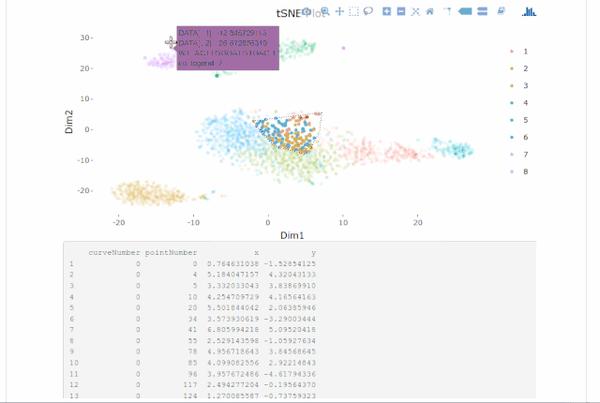
前情回顾:让你的单细胞数据动起来!|iCellR(一)
在上文我们已经基本完成了聚类分析和细胞在不同条件下的比例分析,下面继续开始啦,让你看看iCellR的强大!
1. 每个cluster的平均表达量
my.obj <- clust.avg.exp(my.obj) head(my.obj@clust.avg) # gene cluster_1 cluster_2 cluster_3 cluster_4 cluster_5 cluster_6 #1 A1BG 0.072214723 0.092648973 0.08258609 0 0.027183115 0.072291636 #2 A1BG.AS1 0.014380756 0.003280237 0.01817982 0 0.000000000 0.011545546 #3 A1CF 0.000000000 0.000000000 0.00000000 0 0.000000000 0.000000000 #4 A2M 0.000000000 0.000000000 0.00000000 0 0.007004131 0.004672857 #5 A2M.AS1 0.003520828 0.039985296 0.00876364 0 0.056596203 0.018445562 #6 A2ML1 0.000000000 0.000000000 0.00000000 0 0.000000000 0.000000000 # cluster_7 cluster_8 cluster_9 #1 0.09058946 0.04466827 0.027927923 #2 0.00000000 0.01534541 0.005930566 #3 0.00000000 0.00000000 0.000000000 #4 0.00000000 0.00000000 0.003411938 #5 0.00000000 0.00000000 0.000000000 #6 0.00000000 0.00000000 0.000000000
保存object
save(my.obj, file = "my.obj.Robj")
2. 寻找marker基因
marker.genes <- findMarkers(my.obj, fold.change = 2, padjval = 0.1) # 筛选条件 dim(marker.genes) # [1] 1070 17 head(marker.genes) # row baseMean baseSD AvExpInCluster AvExpInOtherClusters #LRRN3 LRRN3 0.01428477 0.1282046 0.05537243 0.003437002 #LINC00176 LINC00176 0.06757573 0.2949763 0.21404151 0.028906516 #FHIT FHIT 0.10195359 0.3885343 0.31404936 0.045957058 #TSHZ2 TSHZ2 0.04831334 0.2628778 0.14300998 0.023311970 #CCR7 CCR7 0.28132627 0.6847417 0.81386444 0.140728033 #SCGB3A1 SCGB3A1 0.06319598 0.3554273 0.18130557 0.032013232 # foldChange log2FoldChange pval padj clusters #LRRN3 16.110677 4.009945 1.707232e-06 2.847662e-03 1 #LINC00176 7.404611 2.888424 4.189197e-16 7.117446e-13 1 #FHIT 6.833539 2.772633 1.576339e-19 2.681353e-16 1 #TSHZ2 6.134616 2.616973 8.613622e-10 1.455702e-06 1 #CCR7 5.783243 2.531879 1.994533e-42 3.400679e-39 1 #SCGB3A1 5.663457 2.501683 2.578484e-07 4.313805e-04 1 # gene cluster_1 cluster_2 cluster_3 cluster_4 cluster_5 #LRRN3 LRRN3 0.05537243 0.004102916 0.002190847 0 0.010902326 #LINC00176 LINC00176 0.21404151 0.016772401 0.005203161 0 0.009293024 #FHIT FHIT 0.31404936 0.008713243 0.022934924 0 0.035701186 #TSHZ2 TSHZ2 0.14300998 0.008996236 0.009444180 0 0.000000000 #CCR7 CCR7 0.81386444 0.075719109 0.034017494 0 0.021492756 #SCGB3A1 SCGB3A1 0.18130557 0.039644151 0.001183264 0 0.000000000 # cluster_6 cluster_7 cluster_8 cluster_9 #LRRN3 0.002087831 0.00000000 0.000000000 0.012113258 #LINC00176 0.086762509 0.01198777 0.003501552 0.003560614 #FHIT 0.104189143 0.04144293 0.041064681 0.007218861 #TSHZ2 0.065509372 0.01690584 0.002352707 0.015350123 #CCR7 0.272580821 0.06523324 0.257130255 0.031304151 #SCGB3A1 0.078878071 0.01198777 0.000000000 0.043410608 # baseMean: average expression in all the cells 所有细胞的平均表达值 # baseSD: Standard Deviation 标准偏差 # AvExpInCluster: average expression in cluster number (see clusters) 该cluster中的平均表达值 # AvExpInOtherClusters: average expression in all the other clusters 在所有其他cluster的平均表达值 # foldChange: AvExpInCluster/AvExpInOtherClusters 表达差异倍数 # log2FoldChange: log2(AvExpInCluster/AvExpInOtherClusters) 取表达差异倍数的log2的值 # pval: P value # padj: Adjusted P value # clusters: marker for cluster number # gene: marker gene for the cluster cluster的marker gene # the rest are the average expression for each cluster
3. 绘制基因表达情况
基因MS4A1:tSNE 2D,PCA 2D展示该基因在两种降维方式下,每个组的平均表达分布图。Box Plot和Bar plot展示了该基因在每个簇中的表达箱线图和条形图
# tSNE 2D A <- gene.plot(my.obj, gene = "MS4A1", plot.type = "scatterplot", interactive = F, out.name = "scatter_plot") # PCA 2D B <- gene.plot(my.obj, gene = "MS4A1", plot.type = "scatterplot", interactive = F, out.name = "scatter_plot", plot.data.type = "pca") # Box Plot C <- gene.plot(my.obj, gene = "MS4A1", box.to.test = 0, box.pval = "sig.signs", col.by = "clusters", plot.type = "boxplot", interactive = F, out.name = "box_plot") # Bar plot (to visualize fold changes) D <- gene.plot(my.obj, gene = "MS4A1", col.by = "clusters", plot.type = "barplot", interactive = F, out.name = "bar_plot") library(gridExtra) grid.arrange(A,B,C,D) # 4个图合并展示
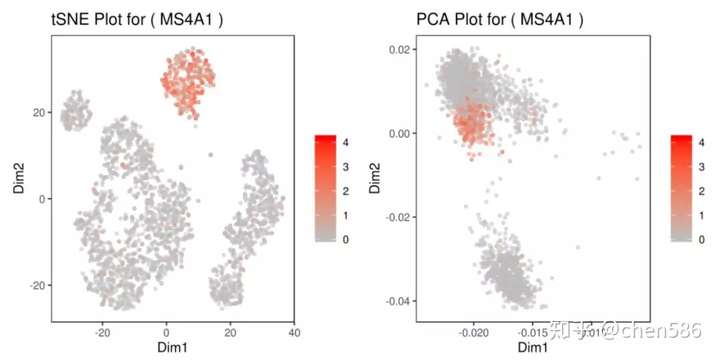
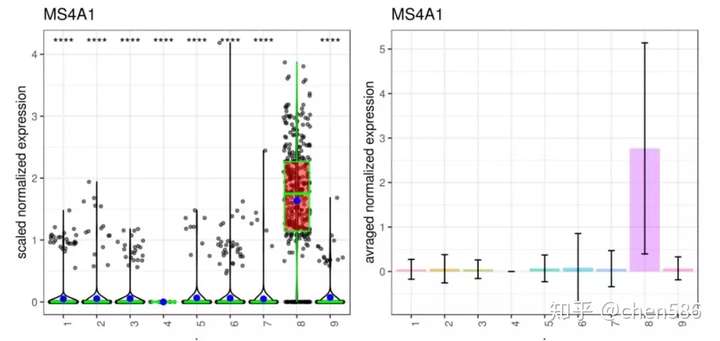
展示多个基因的plots:
genelist = c("PPBP","LYZ","MS4A1","GNLY","LTB","NKG7","IFITM2","CD14","S100A9")
###
for(i in genelist){
MyPlot <- gene.plot(my.obj, gene = i,
interactive = F,
plot.data.type = "umap",
cell.transparency = 1)
NameCol=paste("PL",i,sep="_")
eval(call("<-", as.name(NameCol), MyPlot))
}
###
library(cowplot)
filenames <- ls(pattern="PL_")
plot_grid(plotlist=mget(filenames[1:9]))
热图分析:
# 获取top10高变基因 MyGenes <- top.markers(marker.genes, topde = 10, min.base.mean = 0.2,filt.ambig = F) MyGenes <- unique(MyGenes) # plot heatmap.gg.plot(my.obj, gene = MyGenes, interactive = T, out.name = "plot", cluster.by = "clusters") # or heatmap.gg.plot(my.obj, gene = MyGenes, interactive = F, cluster.by = "clusters")
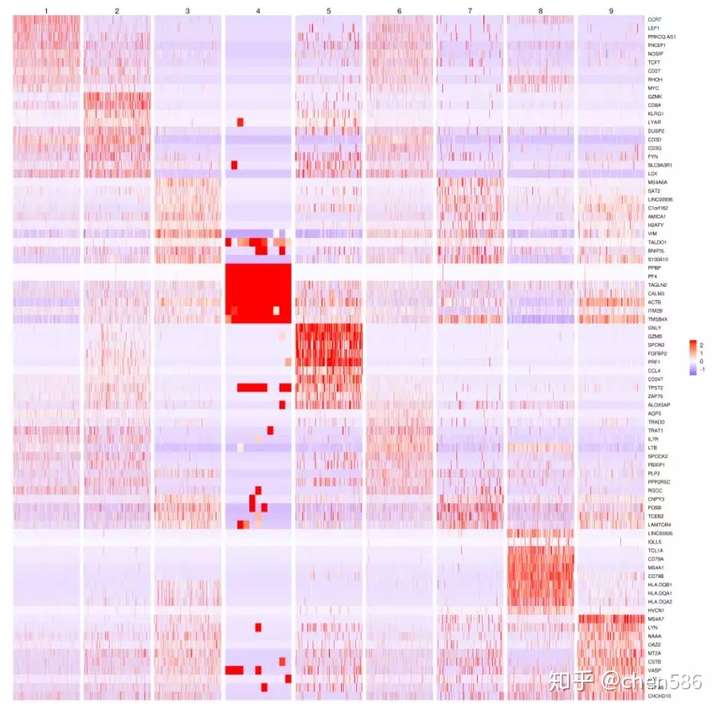
4. 使用ImmGen进行细胞类型预测
注意:ImmGen是小鼠基因组数据,此处的样本数据是人的。对于157个ULI-RNA-Seq(Ultra-low-input RNA-seq)样本,使用的metadata是:
https://github.com/rezakj/scSeqR/blob/dev/doc/uli_RNA_metadat.txt
# 绘制cluster8中top40基因(平均表达值最小为0.2)在不同细胞的表达分布图 Cluster = 8 MyGenes <- top.markers(marker.genes, topde = 40, min.base.mean = 0.2, cluster = Cluster) # 画图 cell.type.pred(immgen.data = "rna", gene = MyGenes, plot.type = "point.plot") # and cell.type.pred(immgen.data = "uli.rna", gene = MyGenes, plot.type = "point.plot", top.cell.types = 50) # or cell.type.pred(immgen.data = "rna", gene = MyGenes, plot.type = "heatmap") # and cell.type.pred(immgen.data = "uli.rna", gene = MyGenes, plot.type = "heatmap") # And finally check the genes in the cells and find the common ones to predict # heatmap.gg.plot(my.obj, gene = MyGenes, interactive = F, cluster.by = "clusters") # 可以看出来cluster 8更像B细胞!# for tissue type prediction use this: #cell.type.pred(immgen.data = "mca", gene = MyGenes, plot.type = "point.plot")
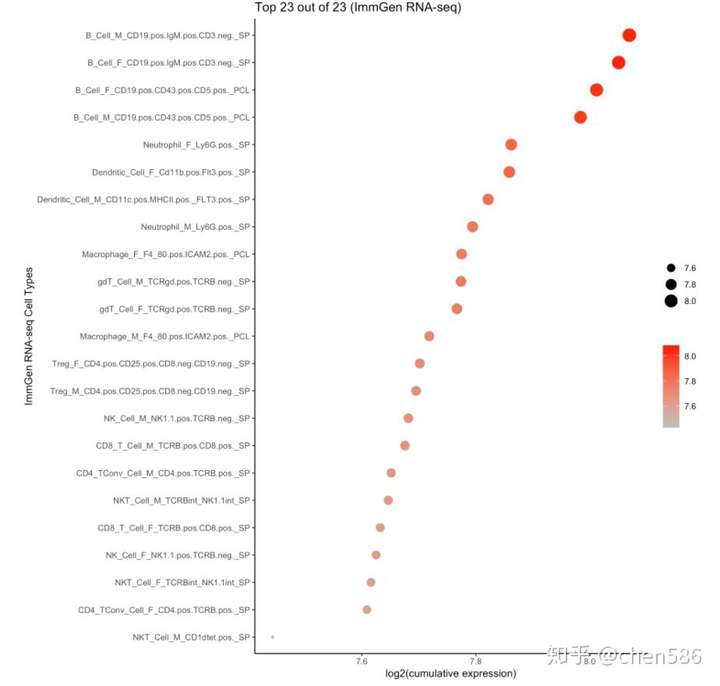

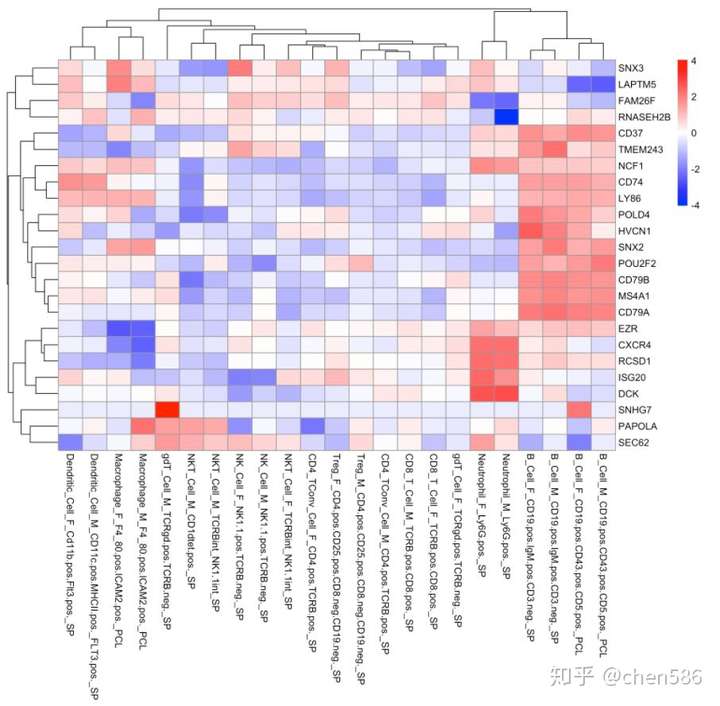
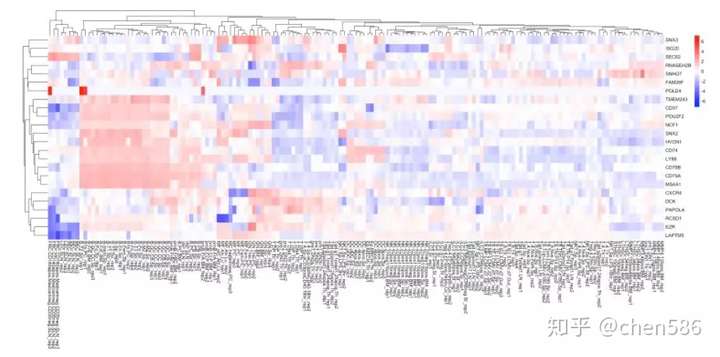
5. Pathway analysis
# cluster7的KEGG Pathway # pathways.kegg(my.obj, clust.num = 7) # this function is being improved and soon will be available 这个函数还要改进,很快就能用了
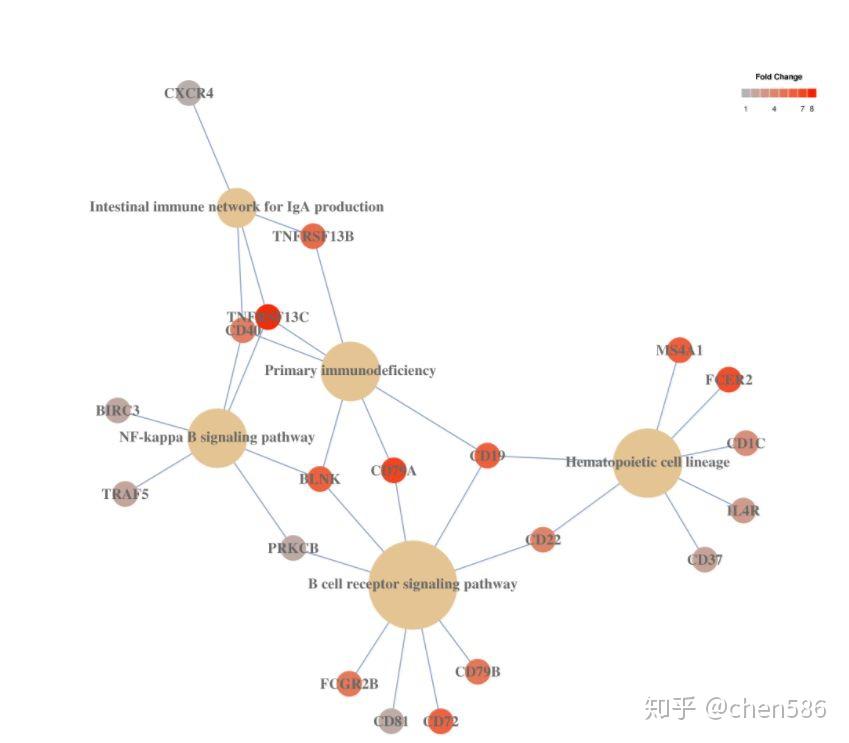
对cluster进行QC:
clust.stats.plot(my.obj, plot.type = "box.mito", interactive = F) # 每个cluster中细胞的线粒体基因分布图 clust.stats.plot(my.obj, plot.type = "box.gene", interactive = F) # 每个cluster中细胞的基因分布图
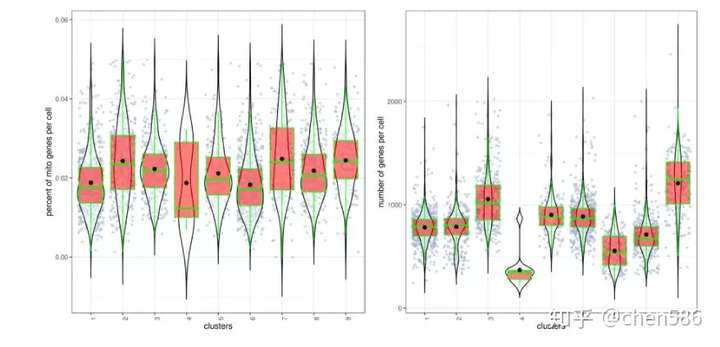
6. 差异表达分析
diff.res <- run.diff.exp(my.obj, de.by = "clusters", cond.1 = c(1,4), cond.2 = c(2)) # cluster之间的比较得到差异表达基因
diff.res1 <- as.data.frame(diff.res)
diff.res1 <- subset(diff.res1, padj < 0.05) # 筛选padj < 0.05的基因
head(diff.res1)
# baseMean 1_4 2 foldChange log2FoldChange pval
#AAK1 0.19554589 0.26338228 0.041792762 0.15867719 -2.655833 8.497012e-33
#ABHD14A 0.09645732 0.12708519 0.027038379 0.21275791 -2.232715 1.151865e-11
#ABHD14B 0.19132829 0.23177944 0.099644572 0.42991118 -1.217889 3.163623e-09
#ABLIM1 0.06901900 0.08749258 0.027148089 0.31029018 -1.688310 1.076382e-06
#AC013264.2 0.07383608 0.10584821 0.001279649 0.01208947 -6.370105 1.291674e-19
#AC092580.4 0.03730859 0.05112053 0.006003441 0.11743700 -3.090041 5.048838e-07
padj
#AAK1 1.294690e-28
#ABHD14A 1.708446e-07
#ABHD14B 4.636290e-05
#ABLIM1 1.540087e-02
#AC013264.2 1.950557e-15
#AC092580.4 7.254675e-03
# more examples 注意参数“de.by”设置的是不同差异比较方式
diff.res <- run.diff.exp(my.obj, de.by = "conditions", cond.1 = c("WT"), cond.2 = c("KO")) # WT vs KO
diff.res <- run.diff.exp(my.obj, de.by = "clusters", cond.1 = c(1,4), cond.2 = c(2)) # cluster 1 and 2 vs. 4
diff.res <- run.diff.exp(my.obj, de.by = "clustBase.condComp", cond.1 = c("WT"), cond.2 = c("KO"), base.cond = 1) # cluster 1 WT vs cluster 1 KO
diff.res <- run.diff.exp(my.obj, de.by = "condBase.clustComp", cond.1 = c(1), cond.2 = c(2), base.cond = "WT") # cluster 1 vs cluster 2 but only the WT sample画差异表达基因的火山图和MA图:
# Volcano Plot volcano.ma.plot(diff.res, sig.value = "pval", sig.line = 0.05, plot.type = "volcano", interactive = F) # MA Plot volcano.ma.plot(diff.res, sig.value = "pval", sig.line = 0.05, plot.type = "ma", interactive = F)

7. 合并,重置,重命名和删除cluster
# 如果你想要合并cluster 2和cluster 3 my.obj <- change.clust(my.obj, change.clust = 3, to.clust = 2) # 重置为原来的分类 my.obj <- change.clust(my.obj, clust.reset = T) # 可以将cluster7编号重命名为细胞类型-"B Cell". my.obj <- change.clust(my.obj, change.clust = 7, to.clust = "B Cell") # 删除cluster1 my.obj <- clust.rm(my.obj, clust.to.rm = 1) # 进行tSNE对细胞重新定位 my.obj <- run.tsne(my.obj, clust.method = "gene.model", gene.list = "my_model_genes.txt") # Use this for plotting as you make the changes cluster.plot(my.obj, cell.size = 1, plot.type = "tsne", cell.color = "black", back.col = "white", col.by = "clusters", cell.transparency = 0.5, clust.dim = 2, interactive = F)
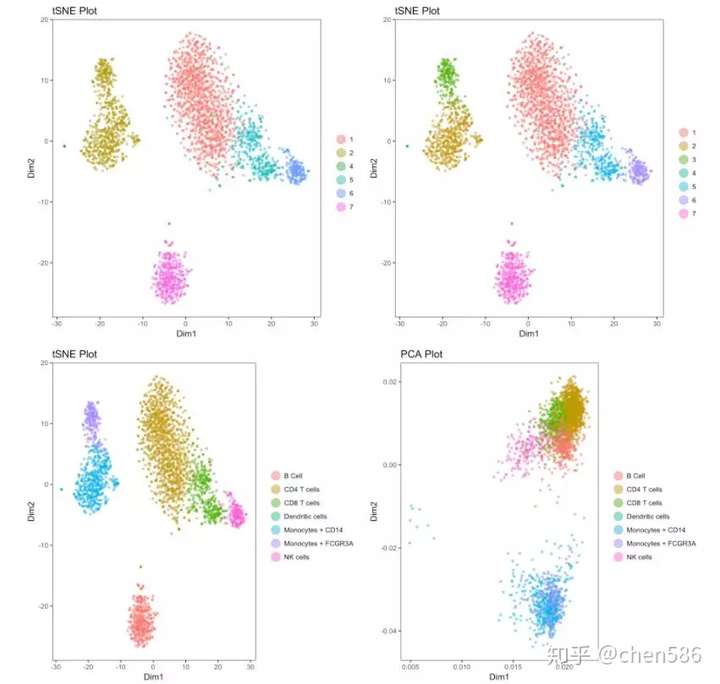
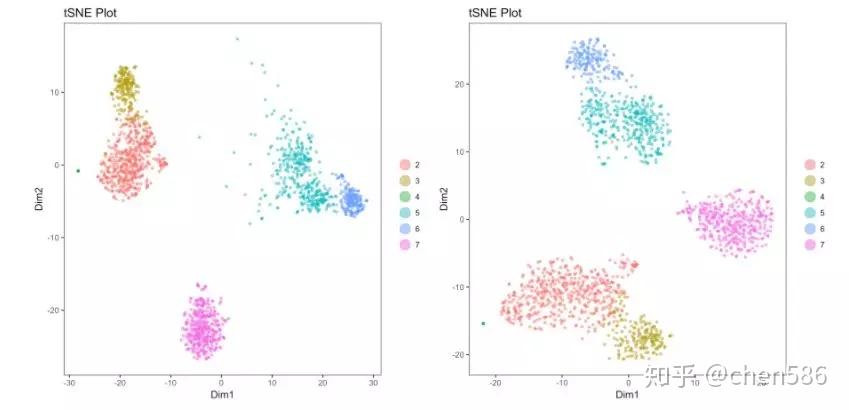
Cell gating:可以框出指定的信息
my.plot <- gene.plot(my.obj, gene = "GNLY", plot.type = "scatterplot", clust.dim = 2, interactive = F) cell.gating(my.obj, my.plot = my.plot) # or #my.plot <- cluster.plot(my.obj, # cell.size = 1, # cell.transparency = 0.5, # clust.dim = 2, # interactive = F)
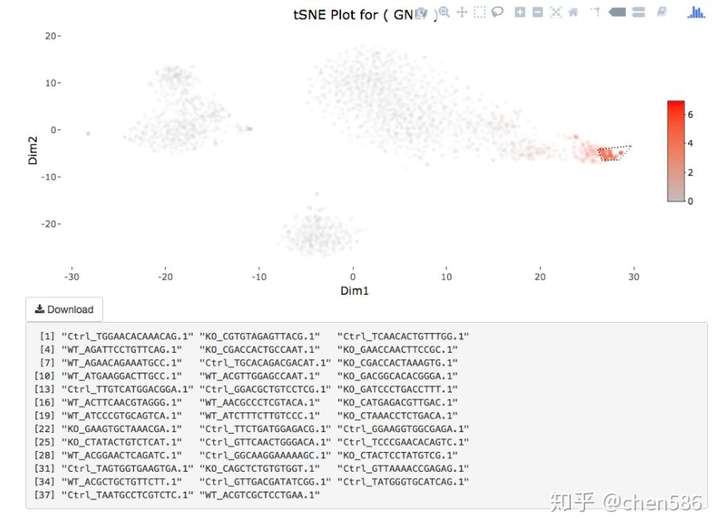

下载细胞ID之后,用下面的命令重命名这些cluster
my.obj <- gate.to.clust(my.obj, my.gate = "cellGating.txt", to.clust = 10)
8. 伪时序分析
注意参数“type”
MyGenes <- top.markers(marker.genes, topde = 50, min.base.mean = 0.2) MyGenes <- unique(MyGenes) pseudotime.tree(my.obj, marker.genes = MyGenes, type = "unrooted", clust.method = "complete") # or pseudotime.tree(my.obj, marker.genes = MyGenes, type = "classic", clust.method = "complete")
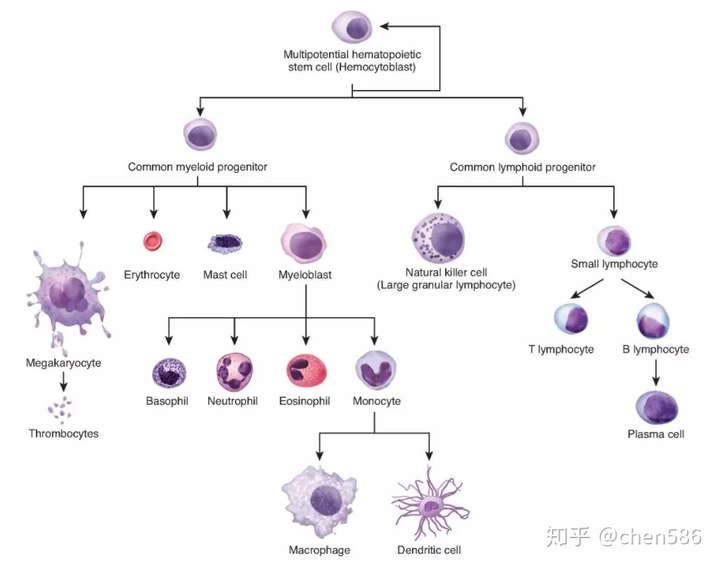
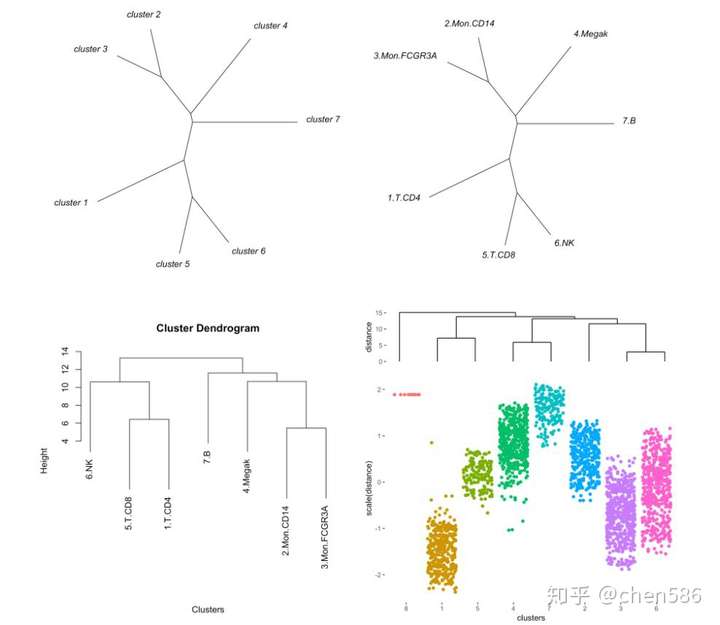
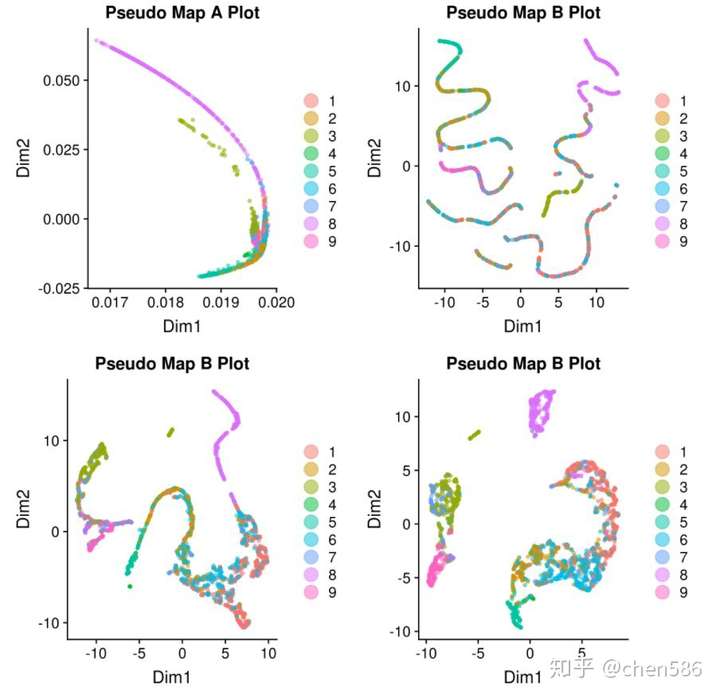
9. 应用monocle进行伪时序分析
library(monocle)
MyMTX <- my.obj@main.data
GeneAnno <- as.data.frame(row.names(MyMTX))
colnames(GeneAnno) <- "gene_short_name"
row.names(GeneAnno) <- GeneAnno$gene_short_name
cell.cluster <- (my.obj@best.clust)
Ha <- data.frame(do.call('rbind', strsplit(as.character(row.names(cell.cluster)),'_',fixed=TRUE)))[1]
clusts <- paste("cl.",as.character(cell.cluster$clusters),sep="")
cell.cluster <- cbind(cell.cluster,Ha,clusts)
colnames(cell.cluster) <- c("Clusts","iCellR.Conds","iCellR.Clusts")
Samp <- new("AnnotatedDataFrame", data = cell.cluster)
Anno <- new("AnnotatedDataFrame", data = GeneAnno)
my.monoc.obj <- newCellDataSet(as.matrix(MyMTX),phenoData = Samp, featureData = Anno)
## find disperesedgenes
my.monoc.obj <- estimateSizeFactors(my.monoc.obj)
my.monoc.obj <- estimateDispersions(my.monoc.obj)
disp_table <- dispersionTable(my.monoc.obj)
unsup_clustering_genes <- subset(disp_table, mean_expression >= 0.1)
my.monoc.obj <- setOrderingFilter(my.monoc.obj, unsup_clustering_genes$gene_id)
# tSNE
my.monoc.obj <- reduceDimension(my.monoc.obj, max_components = 2, num_dim = 10,reduction_method = 'tSNE', verbose = T)
# cluster
my.monoc.obj <- clusterCells(my.monoc.obj, num_clusters = 10)
## plot conditions and clusters based on iCellR analysis
A <- plot_cell_clusters(my.monoc.obj, 1, 2, color = "iCellR.Conds")
B <- plot_cell_clusters(my.monoc.obj, 1, 2, color = "iCellR.Clusts")
## plot clusters based monocle analysis
C <- plot_cell_clusters(my.monoc.obj, 1, 2, color = "Cluster")
# get marker genes from iCellR analysis
MyGenes <- top.markers(marker.genes, topde = 30, min.base.mean = 0.2)
my.monoc.obj <- setOrderingFilter(my.monoc.obj, MyGenes)
my.monoc.obj <- reduceDimension(my.monoc.obj, max_components = 2,method = 'DDRTree')
# order cells
my.monoc.obj <- orderCells(my.monoc.obj)
# plot based on iCellR analysis and marker genes from iCellR
D <- plot_cell_trajectory(my.monoc.obj, color_by = "iCellR.Clusts")
## heatmap genes from iCellR
plot_pseudotime_heatmap(my.monoc.obj[MyGenes,],
cores = 1,
cluster_rows = F,
use_gene_short_name = T,
show_rownames = T)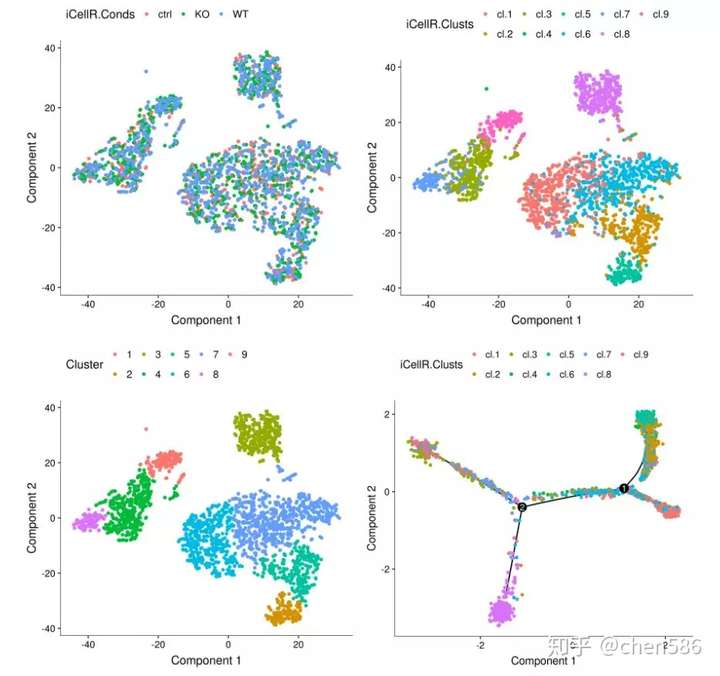
10. iCellR应用于scVDJ-seq数据
# first prepare the files. # this function would filter the files, calculate clonotype frequencies and proportions and add conditions to the cell ids. my.vdj.1 <- prep.vdj(vdj.data = "all_contig_annotations.csv", cond.name = "WT") my.vdj.2 <- prep.vdj(vdj.data = "all_contig_annotations.csv", cond.name = "KO") my.vdj.3 <- prep.vdj(vdj.data = "all_contig_annotations.csv", cond.name = "Ctrl") # concatenate all the conditions my.vdj.data <- rbind(my.vdj.1, my.vdj.2, my.vdj.3) # see head of the file head(my.vdj.data) # raw_clonotype_id barcode is_cell contig_id #1 clonotype1 WT_AAACCTGAGCTAACTC-1 True AAACCTGAGCTAACTC-1_contig_1 #2 clonotype1 WT_AAACCTGAGCTAACTC-1 True AAACCTGAGCTAACTC-1_contig_2 #3 clonotype1 WT_AGTTGGTTCTCGCATC-1 True AGTTGGTTCTCGCATC-1_contig_3 #4 clonotype1 WT_TGACAACCAACTGCTA-1 True TGACAACCAACTGCTA-1_contig_1 #5 clonotype1 WT_TGTCCCAGTCAAACTC-1 True TGTCCCAGTCAAACTC-1_contig_1 #6 clonotype1 WT_TGTCCCAGTCAAACTC-1 True TGTCCCAGTCAAACTC-1_contig_2 # high_confidence length chain v_gene d_gene j_gene c_gene full_length #1 True 693 TRA TRAV8-1 None TRAJ21 TRAC True #2 True 744 TRB TRBV28 TRBD1 TRBJ2-1 TRBC2 True #3 True 647 TRA TRAV8-1 None TRAJ21 TRAC True #4 True 508 TRB TRBV28 TRBD1 TRBJ2-1 TRBC2 True #5 True 660 TRA TRAV8-1 None TRAJ21 TRAC True #6 True 770 TRB TRBV28 TRBD1 TRBJ2-1 TRBC2 True # productive cdr3 cdr3_nt #1 True CAVKDFNKFYF TGTGCCGTGAAAGACTTCAACAAATTTTACTTT #2 True CASSLFSGTGTNEQFF TGTGCCAGCAGTTTATTTTCCGGGACAGGGACGAATGAGCAGTTCTTC #3 True CAVKDFNKFYF TGTGCCGTGAAAGACTTCAACAAATTTTACTTT #4 True CASSLFSGTGTNEQFF TGTGCCAGCAGTTTATTTTCCGGGACAGGGACGAATGAGCAGTTCTTC #5 True CAVKDFNKFYF TGTGCCGTGAAAGACTTCAACAAATTTTACTTT #6 True CASSLFSGTGTNEQFF TGTGCCAGCAGTTTATTTTCCGGGACAGGGACGAATGAGCAGTTCTTC # reads umis raw_consensus_id my.raw_clonotype_id clonotype.Freq #1 1241 2 clonotype1_consensus_1 clonotype1 120 #2 2400 4 clonotype1_consensus_2 clonotype1 120 #3 1090 2 clonotype1_consensus_1 clonotype1 120 #4 2455 4 clonotype1_consensus_2 clonotype1 120 #5 1346 2 clonotype1_consensus_1 clonotype1 120 #6 3073 8 clonotype1_consensus_2 clonotype1 120 # proportion total.colonotype #1 0.04098361 1292 #2 0.04098361 1292 #3 0.04098361 1292 #4 0.04098361 1292 #5 0.04098361 1292 #6 0.04098361 1292 # add it to iCellR object add.vdj(my.obj, vdj.data = my.vdj.data)
reference
如果想尝试一下,这里有传送门哦!
https://blog.sciencenet.cn/blog-118204-1222643.html
上一篇:复现原文(一):Single-cell RNA sequencing of human kidney(step by s
下一篇:2019文献汇总 | 单细胞与病毒感染